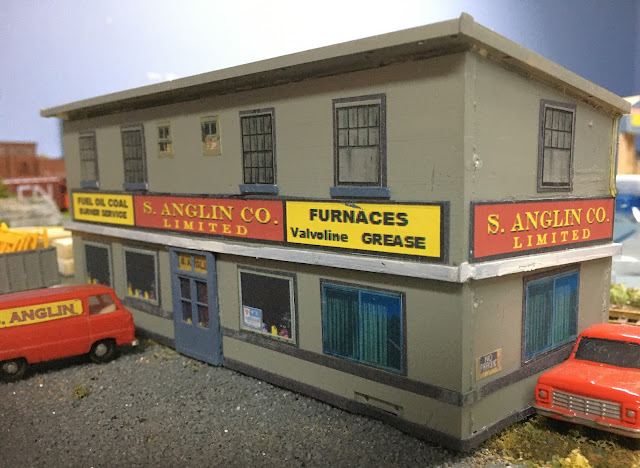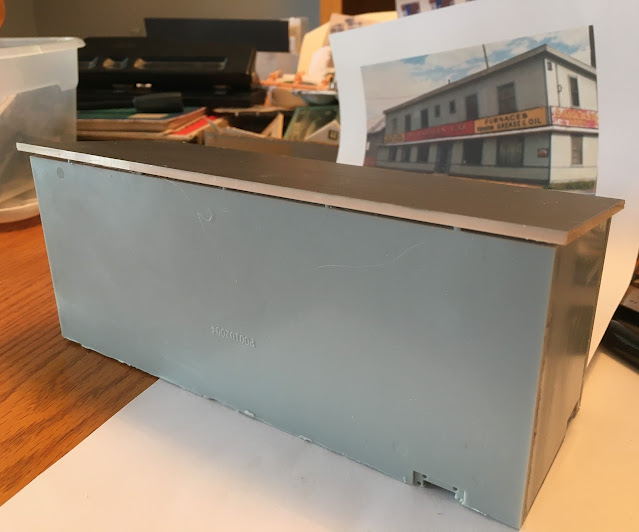In this post, I'm honoured to be able to share photos and original captions of a nice selection of photos taken from various viewpoints around the sharp curve at Kingston's Outer Station in 1951 - taken by the late Frederick Brian Hamer and kindly shared by his son, Ottawa rail enthusiast and model railroader Mike Hamer. I have had the pleasure of
meeting Mike twice while I was a presenter to the Ottawa Valley Associated Railroaders. Mike noted that these images dating from the steam days were very small, but he copied and photographed them, along with the captions his father wrote for each image. Mike also said that it would be an honour to have his Dad's photos shared more widely, and that his Dad would love to know that others were able to enjoy them. Sadly, Mike's Dad passed away a number of years ago but had lived well up into his early nineties - a long and treasured life.
Mike introduces the photos, "Shortly after World War II ended, my parents found themselves living in Kingston, Ontario. In the evening hours, following an early dinner they would hold a “date” a couple of nights each week. With little money to spend, they would drive out to Kingston’s Outer Station to watch the parade of trains, and, if the local ball team were playing a night game, they’d head over to the ballpark afterwards to catch some of the action on the diamond. Before my Dad passed away, he compiled some of the old black and white images he snapped during these wonderful hours spent with Mom trackside. He wrote me a note detailing the activities found in the images. While these are grainy reproductions from very small images long lost, they offer up some tidbits of information of what the train scene was like at the time at Kingston’s Outer Station."
(I have included the captions that Mr. Hamer wrote to Mike in their entirety, with my additional comments [in square brackets] and minimal cropping and and editing of the vintage images). Let's travel back over 70 years, to a time when the Montreal Street station was a busy place and a portal to our city
A westbound passenger train starts from Kingston station behind a 4-8-4 locomotive [CN 6200]. Notice the sharp, right-hand curve in the tracks for the station. This curve was in the middle of a long, uphill grade from the Cataraque River to higher ground west of the city. Friction of the wheel flanges against the curved track added to the difficulty in starting. I remember one occasion when a train was out of control on that up-grade and as it entered the curve in the station the locomotive left the track, fell on its side and slid into the station building. One member of its crew died in that accident [and it will be featured in an upcoming issue of the Canadian Railway Historical Association publication Canadian Rail, the impetus for our online discussion of these very photos].

At Kingston there were facilities to replenish the water tanks of main-line locomotives at both ends of the station. The nearest coal towers were at Brockville, 50 miles to the east and at Belleville, 50 miles to the west. The local switcher and wayfreight locomotive was laboriously coaled by shoveling coal into a large box which was lifted by a crane and dumped into the tender. If several boxes were required this could be a lengthy process which was interesting to watch – but plain hard work for the engine’s crew. [CN E-10-a 924 was built by Kingston's own CLC in 1910 for the Grand Trunk Western, and scrapped a mere four years after this photo was taken.]

At the east end of Kingston’s Outer Station there had been a level crossing where Montreal Street crossed the tracks. After a fatal accident between an auto and a train this was replaced by
an underpass which was in the middle of an S-bend in the road. Because this was a blind curve from either side it still was dangerous because there was only just room for two cars to pass under the bridge. The entire “bottleneck” was eliminated years later. The railroad was diverted to the north and the Outer Station became an industrial subdivision. The bridge was removed and Montreal Street was straightened. A new Kingston Station was built in the west end of an expanded city.

The 6400 class of 4-8-4 locomotives were intended for passenger trains only. These locomotives were given a “skyline casing” over the various appurtenances on top of the boiler and the rounded front. This semi-streamlining was for appearance only as it did almost nothing to reduce the drag of the irregular shapes on the locomotive, which themselves were only a tiny portion of the total drag of an entire train.

Let’s examine diesel traction. Diesel, or Compression-Ignition engines had been used for many years in high-speed, torpedo boats in the world`s navies. Apart from an experimental mainline unit built by CN in 1927, diesel power did not appear on railroads until the makers of diesel engines realized that a huge market would exist on world railroads if diesel locomotives could replace steam. A start was made with low-horsepower locomotives for yardswitching and eventually progressed over 40 years to high-horsepower units for mainline trains. In North America, the diesel engine usually drives an electric generator supplying power to the electric motors `nose-hung` from the truck frames to the axles. In Europe, some diesel locomotives have hydraulic transmissions. [CN 9003 and a classmate built in 1948 by General Motors' Electro-Motive Division lead a westbound train.]

Passenger trains 6 and 15 meet at Kingston. This photograph was taken at the west end of Kingston`s Station. The westbound locomotive has had its fire built up to make steam for the climb ahead while the approaching eastbound train is coasting to its station stop. It will probably replenish its water tank while passengers disembark, and others board the train while mail and express is loaded into the head-end cars immediately behind the locomotive. [This photo is a favourite of mine - a youngster covers his ears - protecting them from what would have been deafening noise from these two behemoths!]
Reverse running of a locomotive on a passenger train is very rare and this picture shows one of those rare occasions. The direction of the plume of smoke confirms the reverse running. I believe this was an advance, extra section of a westbound train which did not stop at the Kingston station and so kept some ten minutes and eight or so miles ahead of the main train which followed.
Locomotive 5554 has a white flag mounted on its handrail, close to the front of the boiler. There will be a similar flag on the other side of the locomotive and these flags tell all railroad employees that the train is an extra section which will shortly be followed by another section of the same train.
Locomotive 5582 would have been an old locomotive when this picture was taken but the life of a steam locomotive could be very long if it had regular repairs, maintenance and parts replacement. In England some steam locomotives survived for almost a hundred years in branchline service where the demands for power were not heavy. [The train is spotted beside the water plug, with one of the towers of the Frontenac Floor & Wall Tile factory visible behind it.]
Ballast cleaning is taking place in this photograph. This train, pictured in the freight yards at Kingston could dig the crushed rock ballast from under the tracks, screen out the dirt, weeds, etc. and replace the ballast as it moved slowly along the tracks. When it was working on a main line, its track was out of use for regular trains and special, single track working arrangements controlled the other track which had to be used safely by trains running in both directions. [Another view of the FF&WT towers.]
We continue to examine the ballast cleaning process. Notice the marking on the hopper car, D.L.&W. which showed that the car belonged to the Delaware, Lackawanna & Western Railroad in the United States of America.
SITIO is the first person singular, indicative mood of the Latin verb meaning “I Thirst.” The circular water tank may have a capacity of ten thousand gallons of water. That is an indication of the huge amount of water consumed by a large steam locomotive when hauling a heavy train. The circular tender was known as a Vanderbilt tender.
CN's 4-8-2 locomotives were not regular visitors to Kingston as there were only a few of them and their normal territory ranged from Toronto west into Southern Ontario. This train is heading eastwards to Montreal. [CN's steel water tower is just visible over the first coach and supplied the water for the tender-filling plugs, as well as some nearby buildings!]
The small locomotive just in front of the caboose of this freight train was being hauled “dead” perhaps to Montreal. In 1951 it was probably going to be scrapped. [The freight train is eastbound and several maintenance-of-way cars are on the track just south of the main line, with the Hanley Spur heading to the right just behind them. I have to wonder if this switcher was CN 7359, shown in a photo below, being taken to Montreal's Pointe St Charles shops for repairs and then returned later, facing the opposite way.]
We find a thirsty 6400 class 4-8-4 locomotive in this photograph. This picture shows that apart from the skyline casing, the deep valance beside the running board and the large diameter of the driving wheels, this loco’s appearance was similar to Canadian National’s other 4-8-4 locomotives. [This is another eastbound train, with the smoke plume of another steam locomotive visible farther east.]
We catch an old timer at work. Locomotive 7359 is working out its days on switching and wayfreight duties in the Kingston area. [Another locomotive is behind it, with a Southern Railway boxcar on the Hanley Spur in the background.]
I’ve titled this image, “The Man in Charge!” This engineer has probably brought his train from Belleville to Kingston and will take it to Brockville, a total distance of about 100 miles. A day’s work for a locomotive crew was measured in miles travelled, not hours worked; a situation which pertained from railroads’ early days. The number of miles per day’s work did not seem to change as train speeds increased over the years. [Top photo of CN 6215 - while engineers were indeed in charge of their locomotives, a steam-era conductor would likely say that's where his train ended, and the conductor's train began!]

“Double Heading” makes a fine title for this photograph [above]. Your mother, Mary, and I were driving along a country road when I heard the tremendous noise of the exhaust of an approaching train. Never having previously heard such decibels, I turned down a country lane to be near the tracks. Two locomotives were working hard to pull a huge freight train up the grade, westbound into Kingston. This gave me the only picture of a double headed steam hauled train I have ever made.













































